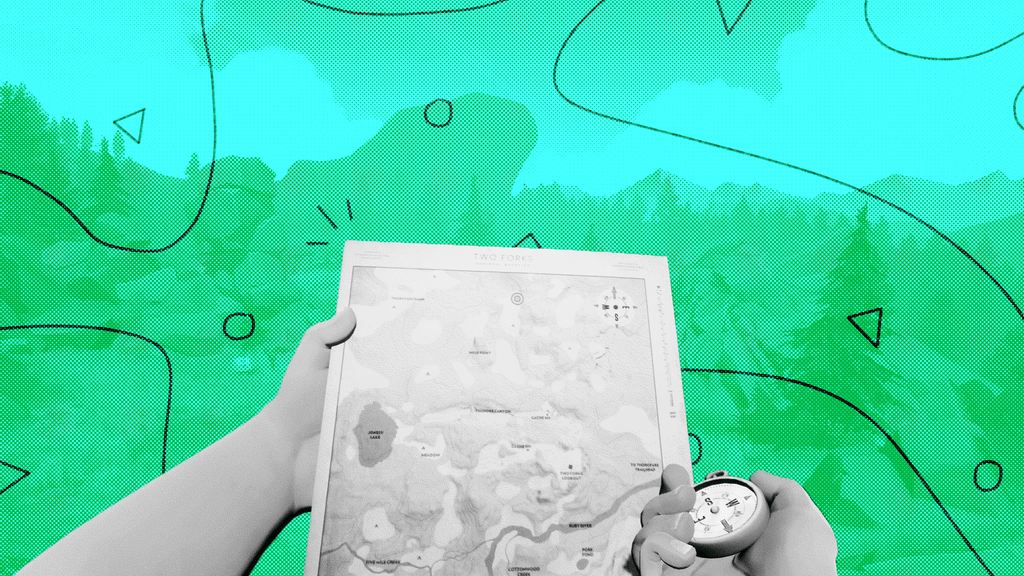Storyclock Research Log
Firewatch

We created the Storyclock Notebook as a research and development tool for screenwriters, but we've boasted since day one that it works for all kinds of storytelling mediums. So this week we thought we'd practice what we preach and use it to research a video game: Campo Santo's FIREWATCH.
I actually played through this game twice back in 2016 when it first released, but for this research log I watched this playthrough video to log the primary narrative beats of the game, using the Storyclock Notebook to visualize its structure in the form of a clock. As you would expect with any game, the player's choices influence much of the finer points and textures of the story, but the broader strokes are more or less the same no matter how you play it. I tried to stick to those broader strokes here. Let's dive in!
Let's Break It Down
- Opening Image: You play through the backstory of your relationship with Julia. This is intercut with your journey up to your lookout tower, where you find your walkie, and are introduced to Delilah.
- Normalcy: DAY 1. You start the day at your typewriter. You exchange some banter with Delilah. Your banter is interrupted by fireworks. You head out of your tower to investigate, learning to use the map to navigate. You need a rope to get down one drop, so you learn to use the cache box. You use the rope -- it breaks (making all future repelling moments slightly suspenseful for you -- and even more importantly, requiring you to go the long way back to the lookout later). You find the naked teens. A funny and compelling interaction ensues. As a fire lookout in a national park, this is your life now. Normalcy™️!
- Normalcy Disrupted: Because the rope broke earlier, you have to go the long way back to the tower, taking in the scenery and getting used to exploring the terrain. You find a cache with a flashlight in it. You have to go into the caves, where you find cave 452, which is locked. Mystery. You emerge from the caves and it’s night (nice offscreen transition by putting you in the caves). You see the FIGURE. Creepy. You get back to your tower to find your typewriter on the ground. You go upstairs to find the place has been broken into. End of Day 1.
- Herald, Acceptance, and Break Into Act 2: DAY 2. Delilah asks you to check on the phone lines that may have gone down during the storm last night. On the way, you overhear her on a suspicious phone call when she accidentally leaves her walkie on. Can we trust Delilah? We find the downed wire, and with it, a bunch of beer cans, and a message from the teens. Great. Now this is war?
- B Story Begins: You find Brian Goodwin's backpack (and his camera), and learn from Delilah who Brian and Ned were. You come upon a mysterious chain link fence in Wapiti Meadow.
- Trailer Moments/Promise of the Premise: We go into a sort of "montage" of days, showing key moments in the development of the mystery with the teens (they've been reported missing), a big fire (which I always chose to title The Big Fire because it's the funniest to me), and your relationship with Delilah (she asks what you look like so she can draw you, she confesses she had a boyfriend named Javier, and she tells you one night that she wishes you could be with her in her tower).
- Midpoint/Things Get Real: DAY 76. You find a clipboard (with a Wapiti Station label on it) with a log of you and Delilah's conversations. Someone hits you on the head, knocking you out. You come to and head to Wapiti Station to investigate, speculating with Delilah on the way about whether or not someone could be listening to you. You get to the fence at Wapiti Station but can't get through the locked gate. Delilah suggests you see if the firefighters at the old scout camp have an axe you can use. You head to the scout camp spending the trek there freaking out with Delilah over the walkie, speculating about what could be going on. You reach the scout camp, where you find a mysterious Wapiti Station memo. You find an axe, but it's too late in the day to make the trek back to Wapiti Station. You hear someone coughing over your conversation, someone who isn't you or Delilah. Someone is definitely listening to you.
- Things Get Worse: DAY 77. Delilah leads you to a cache where she's arranged for a new walkie to be left for you. You get it, and head to Wapiti Station with your axe. On the way, you learn that Delilah chose to lie (or you both did, depending on how you played it earlier in the game) on the police report about your interaction with the missing teens. Delilah is also starting to wonder if she can trust you. You're both getting paranoid.
- Hero's Last Resort: You get to Wapiti Station and use the axe to break in. You find a tent with a beeping tracking device that leads you to the desk where there's a binder full of you and Delilah's conversations. You leave, either choosing to burn the station down in anger or looking back to discover that someone else lit the place on fire (depending on how you play it).
- Game Over: The tracking device starts beeping in the middle of the night. You call Delilah to find that she's drunk, giving up. You follow the signal into the woods to find a backpack with a key to cave 452. Delilah tells you that she can see someone in your tower. You return to it to find a walkman with a recording of your conversation about possibly burning the tent down.
- Break Into Act 3: DAY 78. You head to cave 452 to find answers. Someone locks you in. You find a way out, and discover Brian Goodwin's hideout. Why would he have left all this stuff behind? Your tracking device leads you to a dead elk, leading you to wonder if Wapiti Station was just a normal wildlife research station. Delilah reports that the missing teens showed back up, thus wrapping up our story's two big red herrings.
- Hero Gains "Upper Hand" (The Truth): You descend back into the cave, where you find Brian Goodwin's body.
- Shadow's Final Push: DAY 79. The fire is taking over, and you have to evacuate. But the tracking device is beeping, so you follow it through the smoke and ash to find Ned's confession tape, and his hideout.
- Ultimate Breakthrough: You learn Ned and Brian's tragic story, forcing you to confront the aftermath of running from your problems. You go from there to Delilah's lookout, where you find she's gone on without you. You have one last goodbye over the radio. The helicopter arrives and you get on (or you don't, depending on how you play it).
- Final Image: Delilah's lookout tower as you leave in the helicopter. Your photographs from Brian Goodwin's camera play out over the end credits.
Stuff That Stood Out To Me
- Day 1 is a beautifully contained little piece that has a taste of everything this game has to offer.
- Delilah says you can see the fireworks if you look out your window to the west. They don't actually show up for you until you use your compass to look in the right direction, cleverly teaching you how to play the game in a way that feels organic and spontaneous.
- Day 1 is bookended beautifully with your typewriter. This is a cleverly used prop because it's one we will remember, so when we return to the tower at night to find it on the ground, we instantly feel unsettled because we know that doesn't belong there. Symmetry™️!
- When there are a long walks, they either fill the time with conversation or music.
- I noticed some of their tricks for moving the story in their direction regardless of your choices. Some examples:
- You can grill Delilah on that phonecall she got where she left the walkie on, and she can later admit it was her old boyfriend Javier. Or you can choose not to confront her on it, and she’ll still find a way to later confess to you about Javier, but more as a “I haven’t felt comfortable enough with anyone to talk about this before you.”
- You can choose to burn down Wapiti station, but even if you choose not to, Ned apparently burns it down anyway.
- You can choose to lie on the police report about the missing girls, or you can do the right thing and Delilah will just lie anyway.
- Watching it through this time, I was impressed with how subtly and organically they 100% restrict you to their intended physical paths.
- Firewatch gets compared a lot to another game, Gone Home. But so much of this game is about conversational choices and the relationship you form with Delilah. Gone Home is about figuring out what happened before you arrived. Firewatch is about figuring out what is currently happening, and how it relates to what's happened before.
Narrative structure for games is something I've been fascinated with lately, as there still aren't a lot of rules for how to do it, and the people doing it are constantly talking about it and giving cool talks about it. It's a medium that allows fresh challenges and approaches to storytelling, leading to fresh story experiences like Firewatch or Gone Home. In a lot of ways it's still kind of a wild west, which is super exciting.
We'll be back to analyzing film and TV next time, but we definitely plan to clock some other mediums (TED talks, podcasts, etc) in the future. Have any suggestions? Reach out to us on Twitter and Instagram and let us know!




